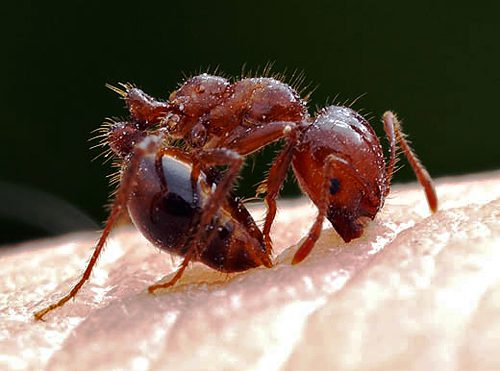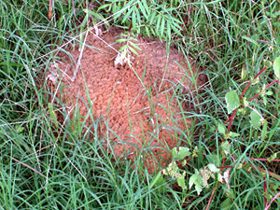The sting of invasive species: When fire ants attack

We talk quite a bit in the conservation community about invasive species and the threats they pose to habitats and ecosystems.We have to deal with invasive species on conserved lands, typically invasive plants like kudzu and privet, which can spread rapidly and choke out native vegetation.
However, other invasives have had an even broader impact on our forests. You may have heard of the hemlock wooly adelgid, an insect that is killing as much as 90 percent of our hemlocks in some places. This is particularly distressing, as the hemlock’s ecosystem is home to numerous different types of species, many of them rare, that are mainly associated with that particular forest type. Another example is the chestnut blight, although less commonly thought of as attributable to an invasive species since its largest impact was so long ago. That invasive fungus wiped out the American chestnut, and along with it, nearly half of our eastern forests in the 1920s and 1930s.
But there is one species we have to deal with far too regularly, one that can create an even more immediate and direct threat – the fire ant. I’ve had several friends in recent weeks encounter these bothersome creatures while in their yards, and it’s none too pleasant. The sting of a fire ant can be extremely painful and even dangerous, especially if you are stung multiple times.
There are more than 280 species of fire ants worldwide, but the invasive fire ant found in the Southern United States is known as the red imported fire ant, Solenopsis invicta. Their origin of entry to this country is believed to have been on cargo that arrived in Alabama from South America in the 1930s.
If you’ve ever been stung by fire ants, you know their stings are immensely painful. Even worse, these can swell into bumps, which may become pustules and persist for days, and could become infected. Fire ants have venom that causes pain and inflammation, and those allergic to the venom can have a severe reaction requiring medical attention.
This venom is comprised of an alkaloid and protein that can be broken down, and so home remedies such as applying diluted bleach or ammonia to the bite (or as a natural alternative lemon or lime juice) work for some people. If applied within a few minutes after being stung, they can reduce the pain and prevent the formation of the pustules. However, if you think you might be allergic to the fire ant’s venom it is important to seek professional medical help.
Many times we encounter fire ants by inadvertently stepping on one of their mounds, in which case they may climb onto your foot or leg and attack as a group. The first ant will bite, which releases a pheromone, and other ants will then bite immediately afterwards. Such  a method of attack is often fatal for small animals, like birds. As a result, many native species are negatively affected by fire ants. Quail and other ground-nesting birds, as well as native bees, are commonly attacked by fire ants. The decline of other species such as southern hognose snakes, has also been attributed, at least in part, to fire ants.
a method of attack is often fatal for small animals, like birds. As a result, many native species are negatively affected by fire ants. Quail and other ground-nesting birds, as well as native bees, are commonly attacked by fire ants. The decline of other species such as southern hognose snakes, has also been attributed, at least in part, to fire ants.
The mounds fire ants create also pose problems for agriculture, as they interfere with farm machinery and can destroy the roots of vegetation and crops. The ants can also attack farm animals, including calves. The FDA estimates more than $5 million is spent annually on medical treatment, damage and control of invasive fire ants; approximately $750 million in agricultural losses are attributable to them.
Scientists are working on control methods, including pesticides and biological controls. For now, though, they are here, and possible encounters with them are reality. It’s good to be aware of fire ants and avoid them whenever possible.